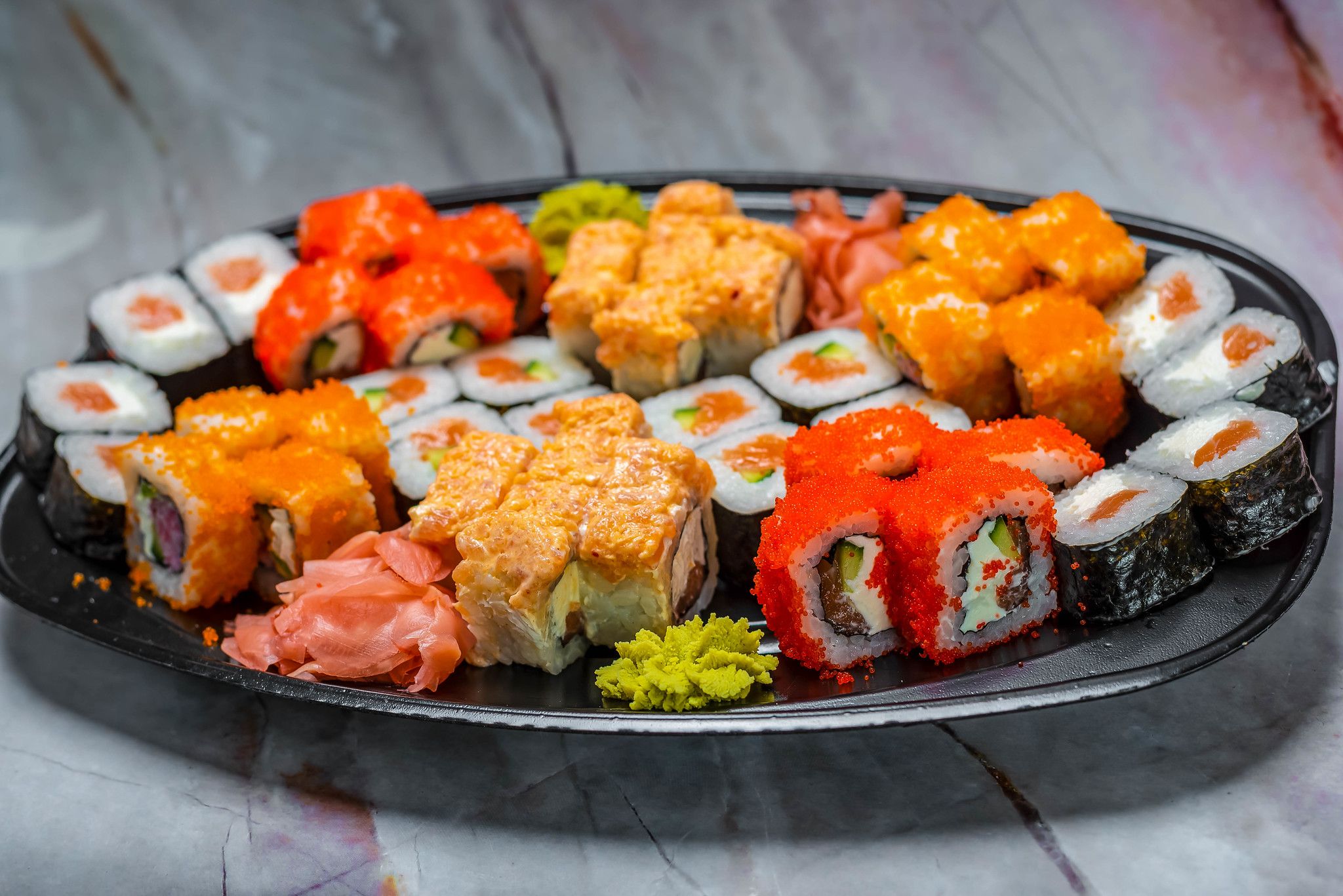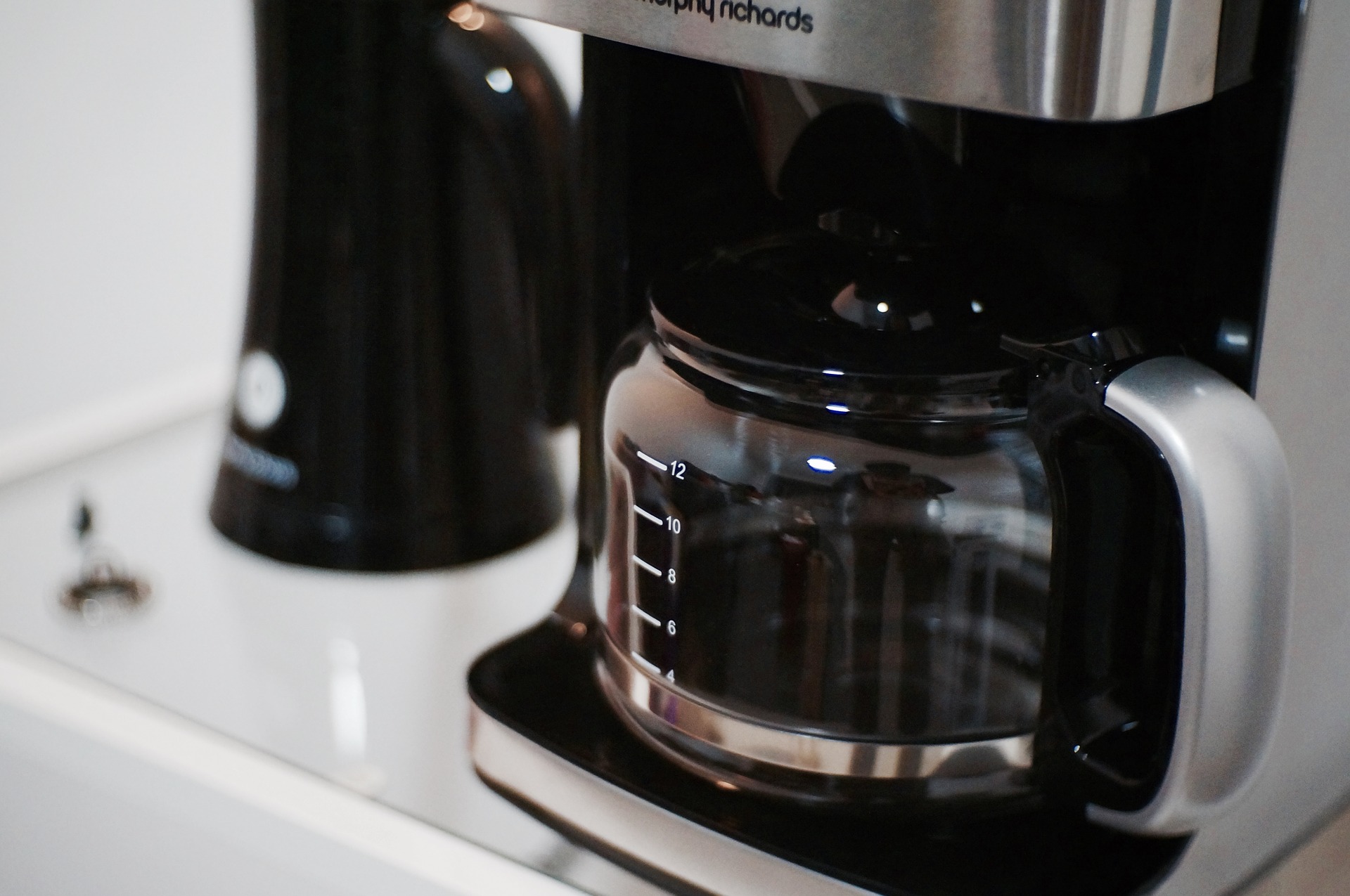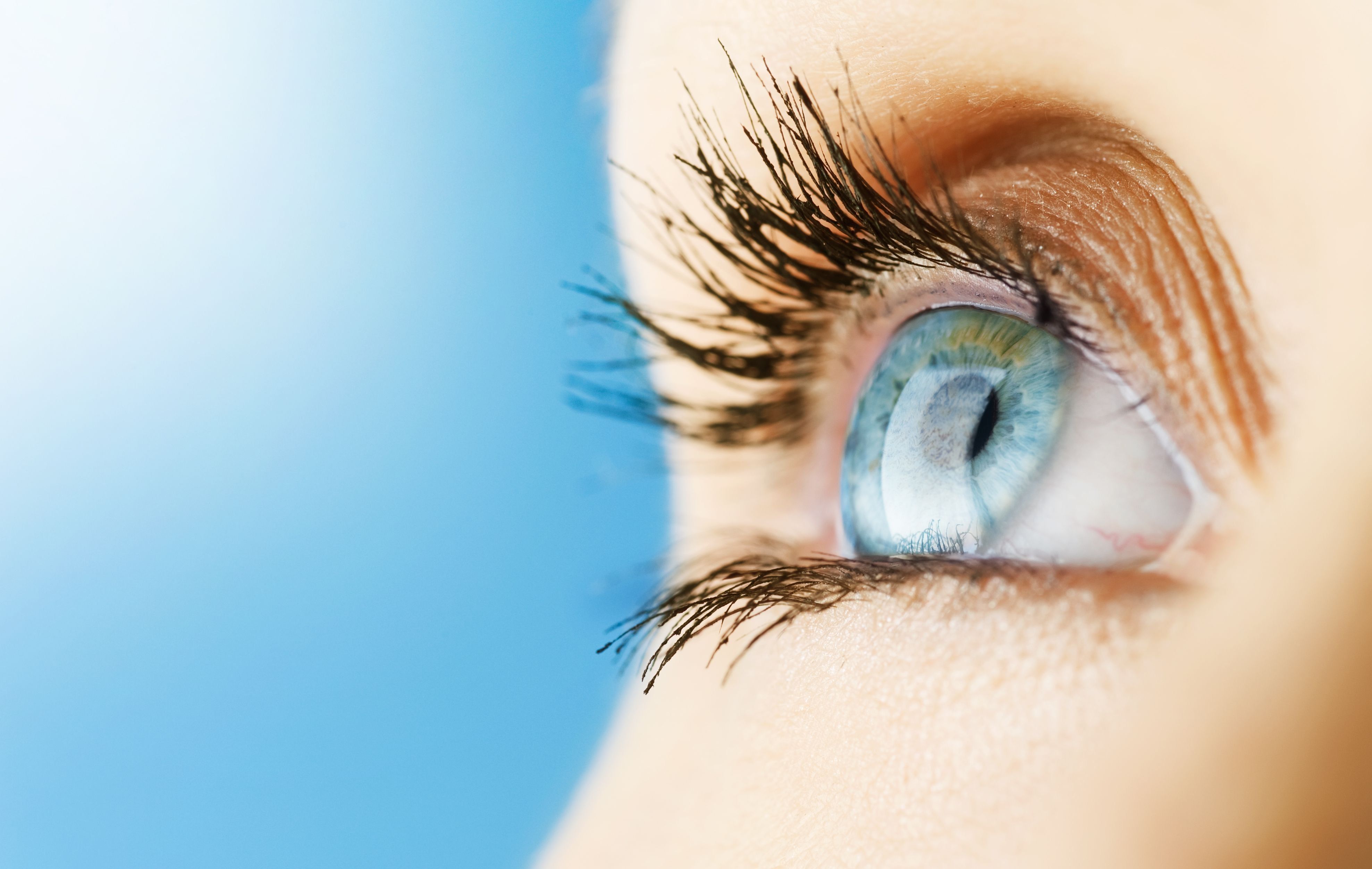Rating of the best mosaic adhesives for 2025
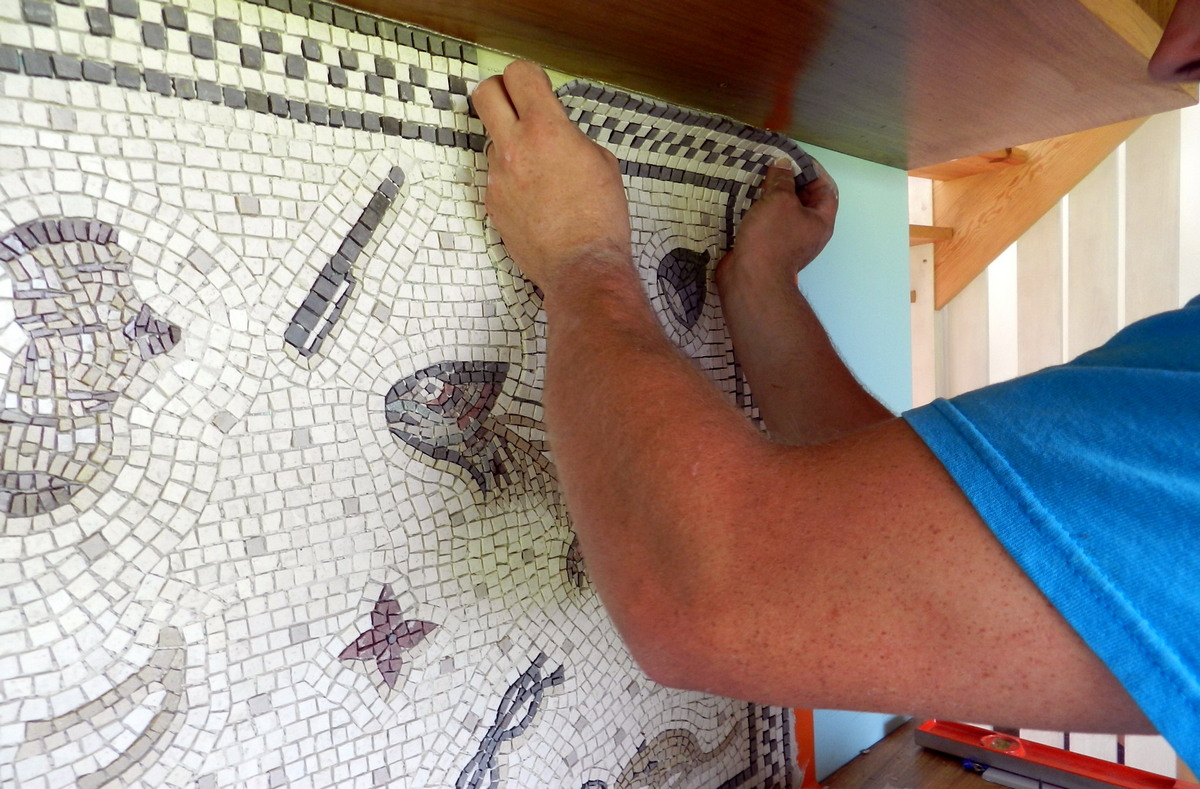
The main advantage of installing a mosaic is that this process can be done independently, because this does not require special skills and knowledge. However, before starting work, you should choose the right adhesive composition and properly prepare the surface for cladding. If there are irregularities on it, they should be leveled, unless the purpose of the work is to repeat the geometric shape of such bulges, because it is with the help of small mosaic fragments that it is best to perform such operations. At the same time, the adhesive must comply with a number of indicators, such as special strength, moisture resistance and successful resistance to various deforming mechanical influences.

Content [Hide]
- 1 Types of mosaic adhesive
- 2 Adhesive work with special surfaces
- 3 Adhesive work with special types of mosaics
- 4 Features of using glue on mosaic
- 5 Mounting Issues
- 6 Difficulties of choice
- 7 Rating of the best mosaic adhesives for 2025
- 8 Conclusion
Types of mosaic adhesive
The most popular mosaic adhesives on the market today are:
- Cement;
- Two-component epoxy;
- Ready-made dispersions;
- Other special blends.
Cement
Cement compositions are usually supplied in the form of dry powders, which must be diluted with water before use, according to the manufacturer's recommendations. The main advantages of these products are high adhesion to the surface (adhesion), good plasticity, affordable cost (they are much inferior in price to two-component epoxides, which makes them very popular). Cement adhesives can also be divided into:
- Rigid;
- elastic;
- With increased elasticity.
The first type is perfect for mounting mosaic fragments on a solid foundation, for example, on a plastered wall or floor (on a concrete screed).The second type should be regarded as a kind of "golden mean", which has good qualities for holding mosaic modules (almost reaching the level of epoxy compositions), but which cost several times less. The third type is highly specialized, and its masters recommend using it when arranging "warm floor" systems either for exterior decoration or for lining the pool bowl. In all these situations, there is a high risk of exposing the panel to temperature changes or frequent vibrations, which can only be extinguished by the high elasticity of the adhesive substance. Also, highly elastic mixtures are preferable for use in new homes, for which future shrinkage will become inevitable.
Epoxy
In such compositions, an epoxy base is used, together with a hardener, which must be mixed exactly before the very installation process. Such substances do not require the content of water in their structure and are able to perfectly fix small module plates on complex substrates, such as metal, wood or glass. This material is considered very expensive, but its advanced functionality fully compensates for the funds spent on it. However, when working with the substance in question, it is imperative to take into account some of the most important factors:
- The application process must take place quickly, because the composition is prone to rapid hardening;
- Glue is best applied to small areas (for the above reason);
- It is better to remove smudges that appear on the front side of the panel immediately, because after hardening it will be very problematic to wash them.
Dispersion
Dispersion compositions are also expensive, they are the last word in mosaic installation and are ready-made viscous substances that only need to be stirred a little before application. Their undoubted advantages include:
- Increased level of adhesion - it can be achieved on almost any substrate;
- Plasticity and elasticity, coupled with the uniformity of the structure;
- The mixture is completely ready for use from the moment the container with it is opened and its additional mixing / dilution is not required;
- It is characterized by minimal consumption and can be applied without much haste;
- There is a possibility of long-term storage in a closed container.
Other mixtures
These include white glue for working with glass or mirror mosaics. For these panels, a colored fixing compound is absolutely contraindicated. In such a situation, professionals recommend the use of two-component epoxy or dispersion compounds, but the use of white cement samples is not prohibited. The main thing is not to spoil the appearance of the laid out image, and so that the colored glue does not show through the transparent / mirror chips-plates. White special adhesives are more often one-component and differ in:
- Increased adhesion;
- Frost resistance and moisture resistance;
- Successfully resist sliding of modules from walls;
- Versatility (can be used for both outdoor and indoor work);
- They can counteract the temperature deformations of the mounted mosaic, which makes it possible to use in the arrangement of "warm floor" systems.
Adhesive work with special surfaces
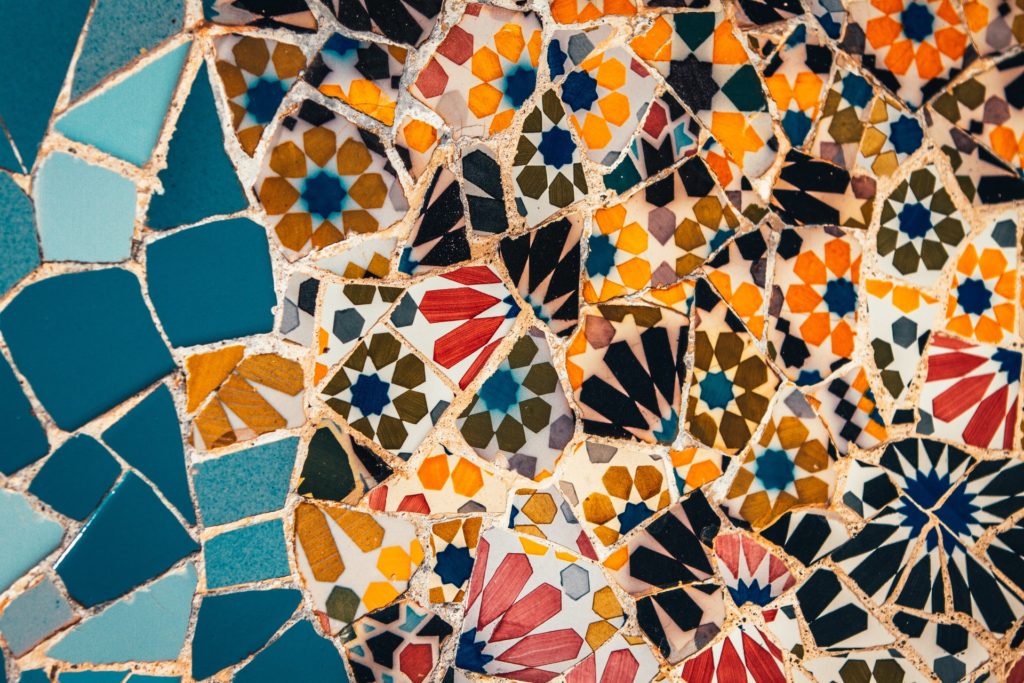
The type of surface on which the mosaic image is supposed to be mounted will depend on the method of processing the base, and not just the type of adhesive used. For example, for a wooden base and an old tile, these procedures will differ.
- Old tile
The laying out of fragment plates is also allowed on the previous finishing material, when there is no possibility of dismantling it or it is simply too lazy to do it. In this case, no special technology is provided, because. it is possible to assume in advance that the base will be even - after all, tiles. But the adhesive composition will need a special one - an aquarium sealant or a silicone mixture will be the best solution. However, before starting work, due to the too smooth surface of the tile, it must be degreased as much as possible and cleaned of various kinds of contaminants.
- wooden base
For it, only two-component epoxy compounds or ready-made dispersion substances are used, the use of cement options is strictly prohibited due to their low adhesion to this type of base. If you use a dispersion agent, then it is better to opt for its acrylic variety. In order to maximize adhesion to the surface, the layer should be applied two or three times one after the other in order to minimize the wood qualities in the absorption (absorption) area.
IMPORTANT! If it is supposed to work on a plywood board, then its thickness should be at least 70 millimeters. Only on such products will the module plates be able to be firmly held by glue, and the entire panel will not collapse under gravity over time.
Adhesive work with special types of mosaics
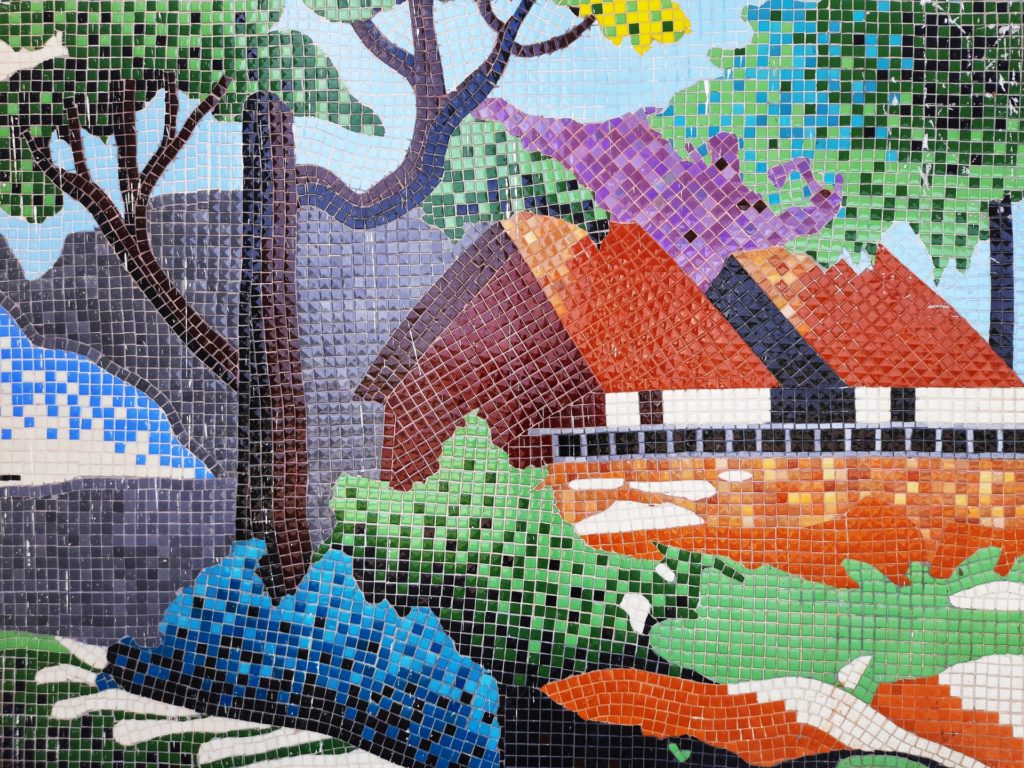
There are several types of mosaic materials for which specific types of adhesive are recommended.For some, a cement option that needs to be kneaded with water is better, while for others, a ready-made mixture. Nevertheless, in most cases, masters try to use gray and white colors, because they are considered universal for many panels, although in some cases uniform saturated and bright solutions are also required.
stone and glass
Glass layouts are more whimsical to the fixing compositions used, because the base is easily visible through their transparent fragments. For glass cladding, it is preferable to use white substances. Even if a little gray mass is added to such a mixture, it will already be perfectly visible from under the finished ornament, which can easily be called a clear distortion of the final desired result. But for stone and ceramics, it is allowed to use any glue, because their dense surface will easily mask all traces of menial work. In this case, a big role will be played by how suitable the solution is for fixing the plates on the base surface. And if we talk about natural stone, then not every mineral is able to stay even on a universal substance - here it is better to get a recommendation from the mosaic manufacturer.
Grid modules
They have been specially designed to simplify the finishing process as much as possible. The vast majority of brands that produce mosaic material have similar models in their assortment. They qualitatively reduce the time of laying out and simplify the further operation of the ornament. The essence of the placement lies in the fact that the whole picture is laid out in separate enlarged modules, which are pre-assembled from small chips-plates and fixed on a grid base. Thus, a large picture can be laid out block by block in a short time.The type of glue is also selected, first of all, focusing on the type of surface to be lined. However, before starting work, the base is subject to special markings so that large blocks do not move and properly fold into a single image. When applying glue to the mesh base of the block, it is imperative to observe the uniformity of the layer, and upon completion of installation, it is necessary to quickly remove all smudges with a wet sponge or rag.
Features of using glue on mosaic
All solutions for fixing small ornaments should be used based on the following tips:
- Any solution must be prepared according to the manufacturer's recommendations (usually they are indicated on the product packaging);
- If the panel is made of polymer, then the glue is applied to the base, and not to the fragment plate;
- The thickness of the layer (when covering exactly the base) should be adjusted with a notched trowel, which can remove excess smudges and leave the same thickness over the entire area;
- If the mosaic fragment has a width of up to 3 millimeters, then a comb with teeth 2-3 millimeters high should be used;
- If a panel is mounted from fragments with an irregular shape and thickness, then the overall picture must be checked periodically using a level in order to maintain the unity of the plane.
Competent expense
The consumption of adhesive mass of each type is standardly indicated on the packaging, for which the manufacturer is responsible. Practice suggests that the consumption will depend on the thickness of the applied layer and the width of each individual module in the ornament. To calculate approximate indicators, you can divide the thickness of the tile by 2 and multiply the result by the average consumption, the value of which is indicated by the manufacturer.So it is possible to get an approximate amount needed to cover one square meter. Then, you just need to multiply the total area by the previously obtained indicator relative to a square meter.
Mounting Issues
If the topic in terms of applying and laying mosaic elements is quite intuitive, then the required tools and the problems of preparing the surface to be trimmed may raise some questions. Speaking of gluing the design material in question, the following tools may be needed:
- Grout seam;
- Cross stitching (if the elements of the ornament have the correct shape);
- Notched spatula;
- Spatula rubber;
- Gloves to protect the skin of the hands during work;
- Soft sponge (rag) for quick removal of smudges;
- Container for mixing/pouring individual portions of glue;
- Construction mixer (for dry samples).
Next, you need to take care of surface preparation. In most cases, its almost perfect evenness will be required. Otherwise, some irregularities will be visually noticeable, and other fragments of the panel will simply disappear. Standard training will include the following steps:
- If there are cracks, they must be sealed with a monolithic solution;
- It is preferable to grind the entire base in order to smooth out unforeseen irregularities;
- All drywall joints and protruding screw heads are also subject to sealing / masking;
- Careful cleaning of all dust is required, and with the help of primer treatment, adhesion can be increased on absorbent surfaces (for example, on wood);
- Double priming of the base will allow the finishing material to better fix;
- To mask the seams (in addition to grouting), it is possible to use special tinting substances.
Difficulties of choice
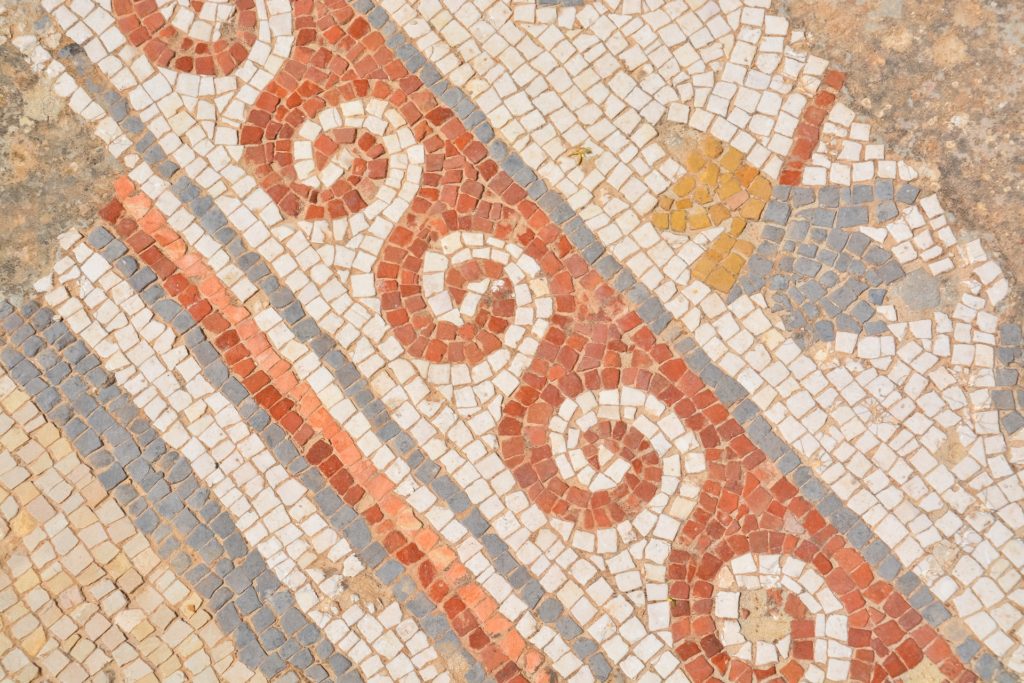
Before buying the necessary fixing agent, it is necessary to take into account the specifics of the base to be decorated, the scope of operation of the room to be lined, as well as the conditions of the application environment. It will also be useful to pay attention to the time during which the finishing mass will harden. If an accelerated pace of production of the entire scope of work is expected, then it is better to give preference to quick-drying products. It is always worth remembering that decorating uneven surfaces, laying individual elements on old ceramics or waterproofing, is best done using highly elastic mixtures. For glass elements, it is necessary to carefully select the fixing agent, because they themselves are very capricious to the conditions of installation procedures. As mentioned above, the best option here would be a white mass. For opaque elements, it is quite possible to use gray solutions made on a cement base or any polyurethane composition.
When decorating with mirror elements fixed on large paper / mesh modules, for example, for finishing the pool bowl, any elastic substance up to black is allowed. However, it is worth remembering that such substances must successfully withstand a large amount of moisture, respectively, liquid latex products can be called the best choice.
To make a mosaic of natural stone, for example, using marble decoration components, it is necessary to take into account the characteristics of the mineral rock. Some of them may even change their color when in contact with the wrong adhesive. The general recommendation of professionals for such cases is the use of cement or reactive substances.
Rating of the best mosaic adhesives for 2025
Budget segment
3rd place: "AF05-071-01 ART format 100 ml"
votes 0
This unique product is intended for any decorative elements. The main feature is its transparency, due to which, even if drops fall on the surface of the decor, the latter does not lose its original appearance. Characteristics: versatility and transparency, container volume in ml. - 100. Focused on the use in the field of small repairs. The recommended cost for retail chains is 360 rubles.
- Democratic price;
- Versatility and transparency;
- Easy removal from the surface.
- Very small container.
2nd place: "Glims WhiteFix 5 kg"
votes 0
Another sample designed for installation of ceramic and glass mosaics, natural and artificial stone. It can be applied both to external, and to internal works. Great for finishing swimming pools, laundries, terraces, showers and sanitary rooms. It is characterized by a capacious container. The recommended cost for retail chains is 370 rubles.
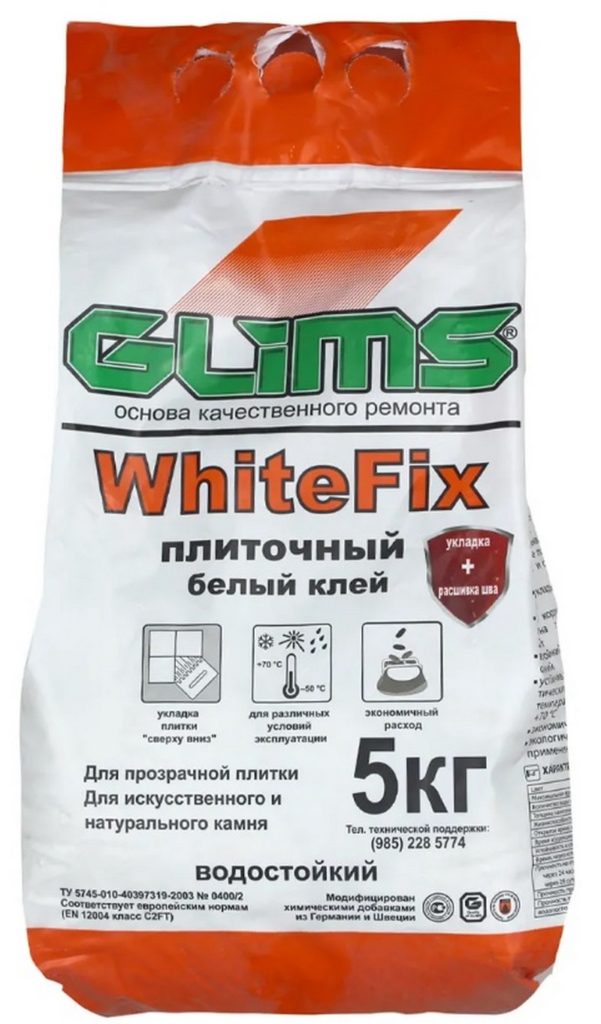
- Very capacious container;
- Adequate price;
- Moisture resistance.
- Not detected.
1st place: "Ceresit 48617 5 kg"
votes 0
The latest and latest variation of this dry building mix is brought into line with GOST R 56387-2018. It is designed for fixing tiles of all types of marble, light limestone, translucent stone, and glass mosaics, on non-deforming mineral substrates (such as concrete, cement screeds, cement and cement-lime plasters), on walls inside and outside buildings, and on floors inside buildings, incl. in rooms with constant humidity and on heated screeds, walls of balconies and terraces, etc.Ensures the absence of stains and efflorescence on marble cladding; water and frost resistance; resistant to sliding tiles; can be used on heated screeds; suitable for indoor and outdoor use; environmentally safe. With the addition of SS 83 elasticizer, the sample can be used: on external stairs, entrance groups, floors of balconies and terraces, exploited roofs; in indoor and outdoor pools and water tanks; on heated screeds outside buildings; on plasterboard sheets, GVL, chipboard, OSB; on gypsum and anhydride bases; on waterproofing coatings; on old tile facings; on light, cellular and "young" (at least 1 month old) concrete. The use of products based on white cements avoids stains and efflorescence on marble. Carpet ornament in pools is recommended to be used only by fastening from the front side. The recommended cost for retail chains is 510 rubles.
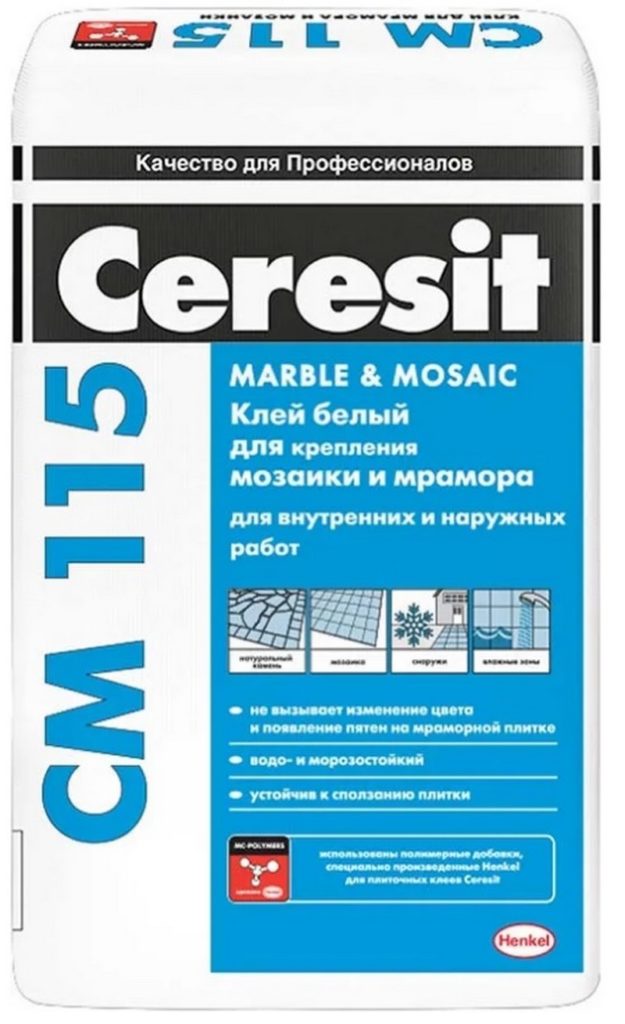
- Sufficient volume;
- Almost complete versatility;
- Ease of preparation.
- Not detected.
Middle price segment
3rd place: "KUDO 300 ml for mirror tiles/mosaics"
votes 0
Recommended for gluing and mounting all types of mirrors/mosaics and mirror tiles. Consumption is 1 tube per 1 sq.m.It is characterized by high strength and durability of joints, does not destroy the mirror amalgam, is ideal for all types of mirrors, is resistant to surface deformations, temperature fluctuations and air humidity, suitable for kitchen and bathrooms, moisture resistant - does not absorb water and does not lose its mechanical properties in wet rooms , possesses excellent adhesion to the majority of building surfaces, quickly seizes, filling gaps on uneven surfaces. The recommended cost for retail chains is 640 rubles.
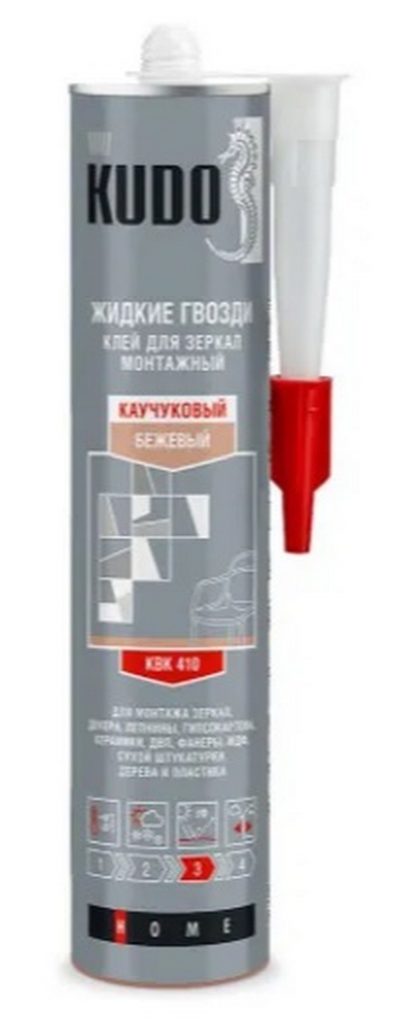
- Excellent operational characteristics;
- Mirror amalgam protection;
- Increased strength.
- Too much expense.
2nd place: "LITOKOL LITOPLUS K55 5 kg"
votes 0
This cement sample now has improved technical characteristics, thixotropy, with increased open time, belongs to the C2 TE class according to the GOST R 56387 classification. It is a dry mix based on white cement. After mixing with water, it forms a pasty, elastic adhesive solution with high adhesive properties. It has a high thixotropy, which makes it possible to exclude slipping of tile fragments when facing vertical surfaces. Water-, frost-resistant. Environmentally friendly, does not contain asbestos fibers. Applications: for exterior and interior cladding with glass/ceramic/stone mosaics, porcelain stoneware, as well as ceramic and natural stone tiles up to 60x60 cm.Since the adhesive is white, it is especially recommended for colored and transparent glass ornaments and natural white stone tiles, as it does not change the original color of the material. The recommended cost for retail chains is 710 rubles.
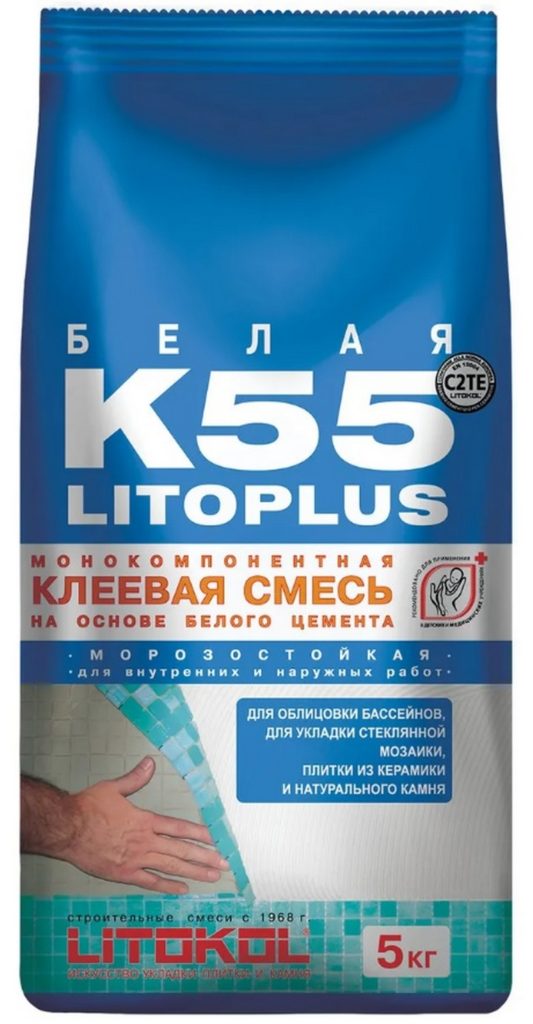
- Updated composition formula;
- Versatility;
- Decent value for money.
- Not detected.
1st place: "UNIS Belfix white (С1), 5 kg"
votes 0
This sample is used for laying ceramic, porcelain stoneware, glass tiles, glass blocks, natural stone slabs on floors and walls in any premises: wet, dry, freezing and heated. Tile format up to 90x90 cm. It is used for outdoor work, building cladding. Recommended for difficult tasks: laying on top of old tiles, use in the "warm floor" system, lining of water tanks (pools). It can be used as a grout for tile joints or to create artistically decorative effects (panels, reliefs, etc.). It is used on non-deformable bases: concrete (including cellular concrete and slag concrete), cement (including cement plaster), brick, gypsum (GKL, GVL, PGP) and others. The recommended cost for retail chains is 740 rubles.
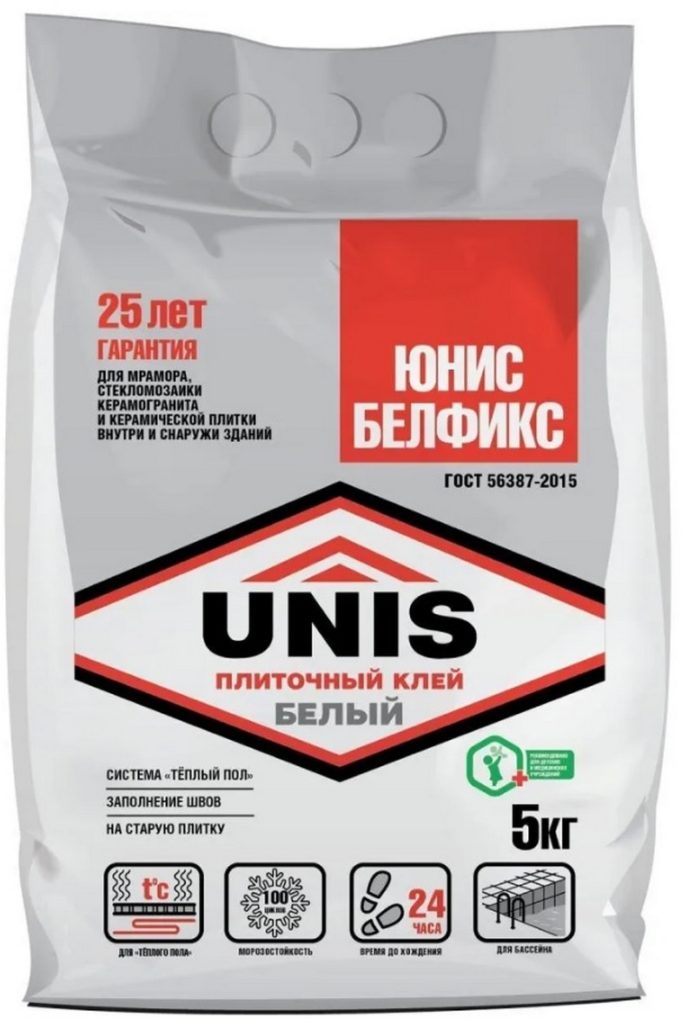
- Consumption when using a spatula 6x6 mm - 3.0 kg / m²;
- The pot life of the solution is 180 minutes;
- Tile laying time - 20 minutes;
- Tile adjustment time - 15 minutes;
- The strength of the adhesive joint in an air-dry environment is up to 1.2 MPa;
- The strength of the adhesive joint in other environments is not less than 0.5 MPa;
- Resistant to tile slipping, no more than 0.5 mm;
- Shelf life - 12 months.
- Not detected.
Premium class
2nd place: "Mapei Kerabond T-R gray (class C1) 25 kg"
votes 0
This moisture-resistant, high-performance sample is designed to work on ceramics, porcelain stoneware. Work can be carried out both internally and externally. The composition includes cement and polymer additives. Color - grey. Water consumption per package of dry mix: about 6-6.5 liters. There is a possibility for application on a "heat-insulated floor". Adjustment time - up to 45 minutes. Alkali resistant. It is necessary to use the double application method. The recommended cost for retail chains is 3400 rubles.
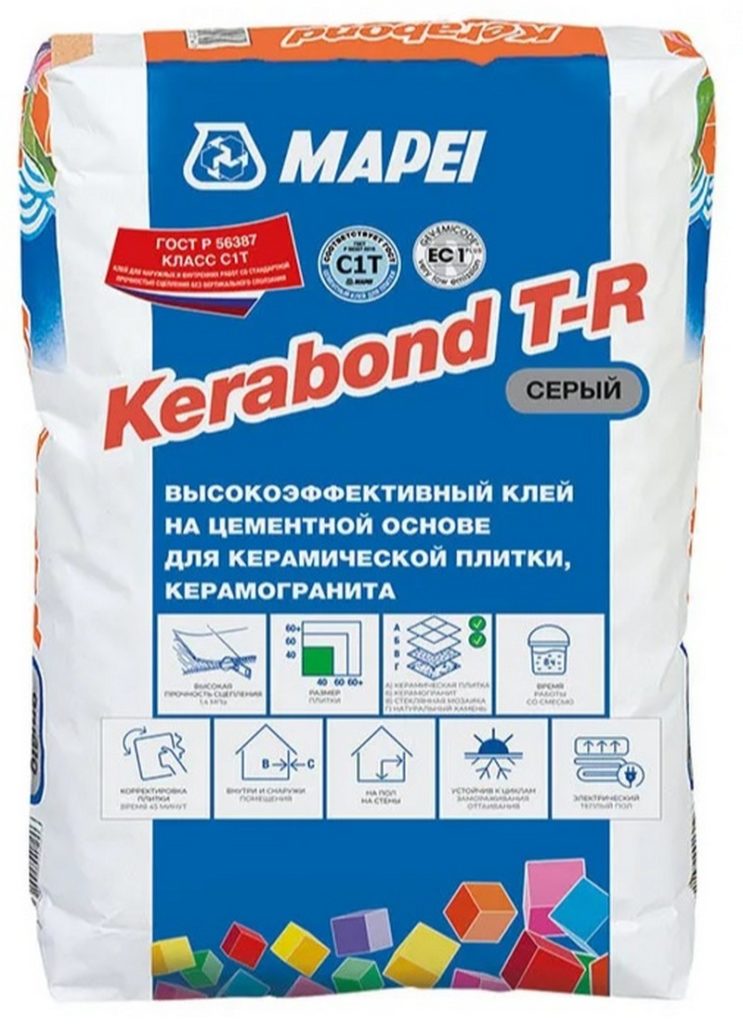
- Grey colour;
- Large packing - 25 kilograms;
- Alkali resistance.
- Not detected.
1st place: "LitoPlus K55 for swimming pools frost-resistant white C2TE 25 kg"
votes 0
The latest modification of a very popular mixture, which, thanks to special additives, is able to achieve excellent technical characteristics of the mortar. It has proper thixotropy (viscosity change depending on the load), increased plasticity time of the finished mixture, water and frost resistance. This allows the product to be used for laying all types of tiles/mosaics both for outdoor and indoor finishing work, in rooms with high humidity (pools, saunas, bathrooms, etc.). Due to the white color, it can be applied to transparent and glass surfaces, white stone, when facing kitchens, showers, and flooring. The finished mixture is plastic, has high adhesive properties. There is no slipping of tiles when laying on vertical surfaces, does not contain fibers. The recommended cost for retail chains is 5400 rubles.
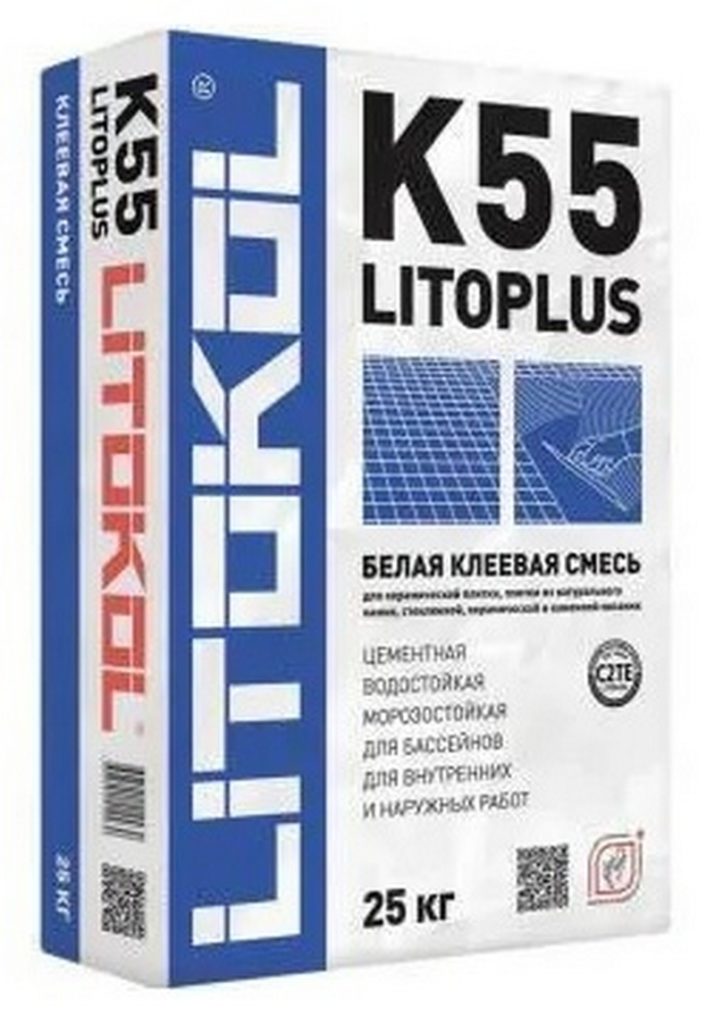
- Improved composition modification;
- Strength;
- Working with large areas.
- Not detected
Conclusion
For many, mosaic tiles are associated with exotic oriental baths and luxurious pools, but today the range of its use is much wider. Facing with exquisite mosaics can give the design of an ordinary bathroom, kitchen or living room a special charm. The decorative possibilities of this tile allow designers to think boldly and in an original way. In the embodiment of design ideas, the craftsmen are helped by a special adhesive for the mosaic, the use of which guarantees high-quality, reliable fixation of each fragment.
new entries
Categories
Useful
Popular Articles
-

Top ranking of the best and cheapest scooters up to 50cc in 2025
Views: 131649 -

Rating of the best soundproofing materials for an apartment in 2025
Views: 127688 -

Rating of cheap analogues of expensive medicines for flu and colds for 2025
Views: 124517 -

The best men's sneakers in 2025
Views: 124031 -

The Best Complex Vitamins in 2025
Views: 121938 -

Top ranking of the best smartwatches 2025 - price-quality ratio
Views: 114978 -

The best paint for gray hair - top rating 2025
Views: 113393 -

Ranking of the best wood paints for interior work in 2025
Views: 110318 -

Rating of the best spinning reels in 2025
Views: 105327 -

Ranking of the best sex dolls for men for 2025
Views: 104363 -

Ranking of the best action cameras from China in 2025
Views: 102214 -

The most effective calcium preparations for adults and children in 2025
Views: 102010

